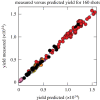Direct-drive laser fusion: status, plans and future
- PMID: 33280561
- PMCID: PMC7741011
- DOI: 10.1098/rsta.2020.0011
Direct-drive laser fusion: status, plans and future
Abstract
Laser-direct drive (LDD), along with laser indirect (X-ray) drive (LID) and magnetic drive with pulsed power, is one of the three viable inertial confinement fusion approaches to achieving fusion ignition and gain in the laboratory. The LDD programme is primarily being executed at both the Omega Laser Facility at the Laboratory for Laser Energetics and at the National Ignition Facility (NIF) at Lawrence Livermore National Laboratory. LDD research at Omega includes cryogenic implosions, fundamental physics including material properties, hydrodynamics and laser-plasma interaction physics. LDD research on the NIF is focused on energy coupling and laser-plasma interactions physics at ignition-scale plasmas. Limited implosions on the NIF in the 'polar-drive' configuration, where the irradiation geometry is configured for LID, are also a feature of LDD research. The ability to conduct research over a large range of energy, power and scale size using both Omega and the NIF is a major positive aspect of LDD research that reduces the risk in scaling from OMEGA to megajoule-class lasers. The paper will summarize the present status of LDD research and plans for the future with the goal of ultimately achieving a burning plasma in the laboratory. This article is part of a discussion meeting issue 'Prospects for high gain inertial fusion energy (part 2)'.
Keywords: direct drive; inertial confinement fusion; laser fusion.
Conflict of interest statement
We declare we have no competing interests.
Figures


















References
-
- Nuckolls J, Wood L, Thiessen A, Zimmerman G. 1972. Laser compression of matter to super-high densities: thermonuclear (CTR) applications. Nature 239, 139–142. ( 10.1038/239139a0) - DOI
-
- Lindl JD. 1998. Inertial confinement fusion: the quest for ignition and energy gain using indirect drive. New York, NY: Springer.
-
- Betti R, Hurricane OA. 2016. Inertial-confinement fusion with lasers. Nat. Phys. 12, 435–448. ( 10.1038/nphys3736) - DOI
-
- Sinars DB, et al. 2020. Review of pulsed power-driven high energy density physics research on Z at Sandia. Phys. Plasmas 27, 070501 ( 10.1063/5.0007476) - DOI
-
- Campbell EM, Hogan WJ. 1999. The National Ignition Facility—Applications for inertial fusion energy and high-energy-density science. Plasma Phys. Control. Fusion 41, B39–B56. ( 10.1088/0741-3335/41/12B/303) - DOI
LinkOut - more resources
Full Text Sources

